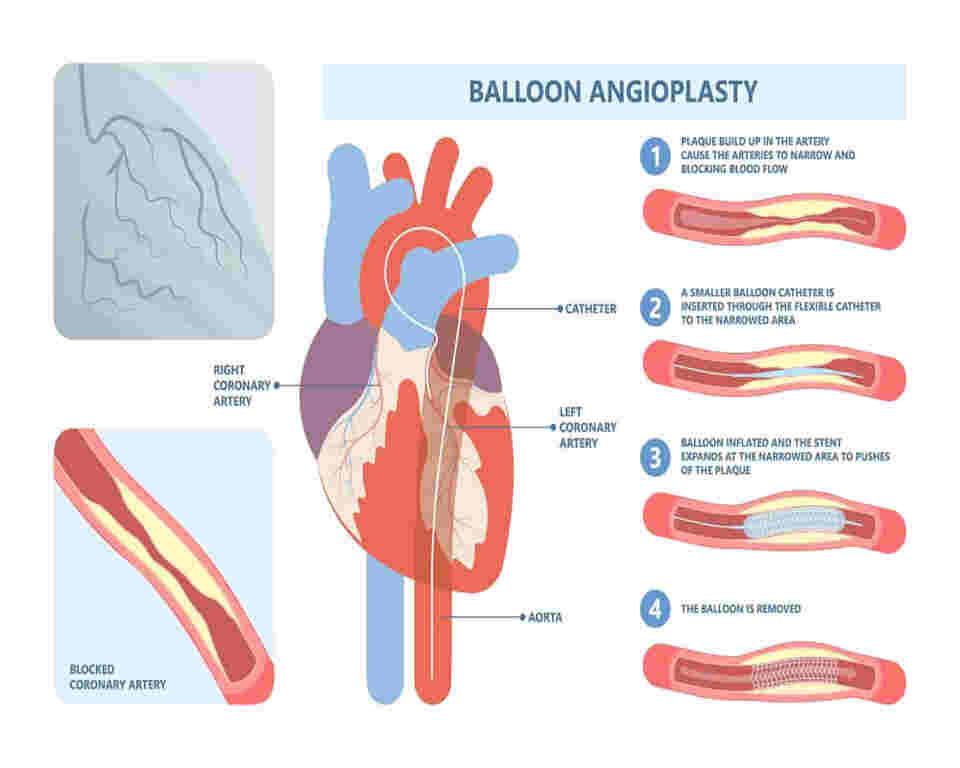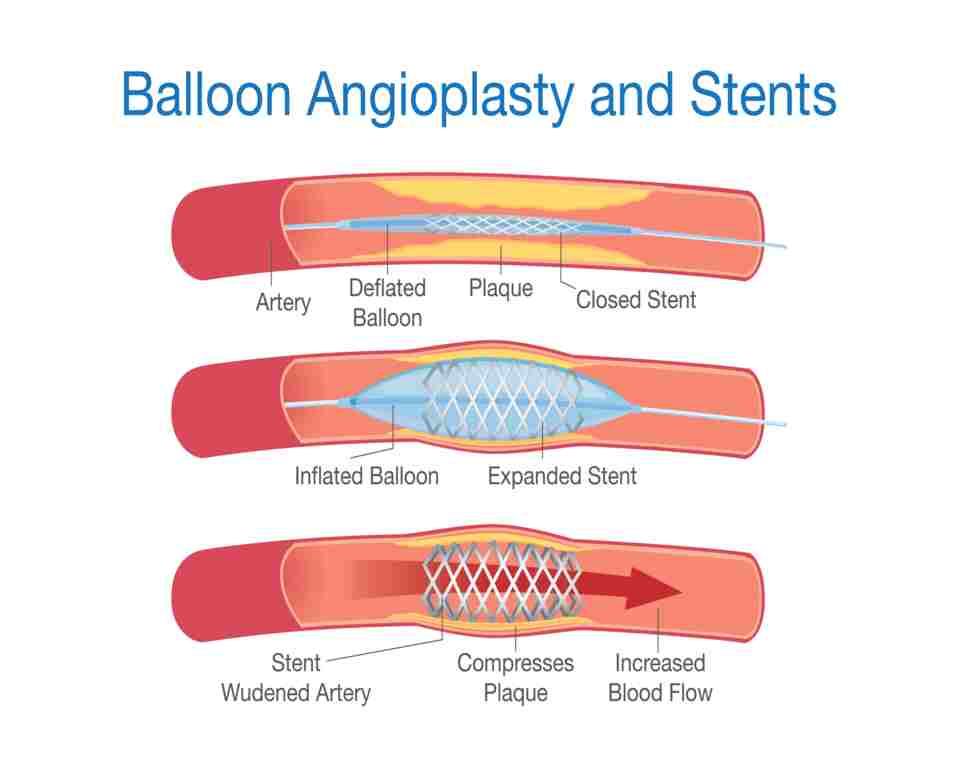
Angiogram vs Angioplasty In the intricate realm of cardiovascular health, two procedures stand out as pivotal tools for unveiling the secrets of a beating heart: Angiogram vs Angioplasty and angioplasties.
While these terms may sound similar, they represent distinct paths in the journey toward maintaining a healthy heart.
Imagine being told that your heart, the vital organ that keeps you alive, is facing a potentially life-threatening issue.
With heart disease being the leading cause of death worldwide, understanding the diagnostics and treatment options available is crucial for safeguarding your heart health.
In this comprehensive guide, we’ll embark on a voyage through the five key contrasts between angiogram vs angioplasty, empowering you with the knowledge to make informed decisions about your cardiovascular well-being.
Table of Contents
ToggleKey Takeaways:
Angiogram vs. Angioplasty:
An angiogram is like a detective, using X-ray snapshots to spot any trouble in your heart’s arteries. It’s all about finding problems.
Angioplasty steps in as the fixer-upper, widening narrow or blocked arteries to keep your heart’s blood flow smooth.
How They Work:
Both start with a tiny tube journey through your arteries. For angiograms, it’s about injecting dye to see inside.
For angioplasties, it’s about fixing issues with a balloon and possibly leaving a stent to keep things open.
Safety First:
Angiograms are pretty safe with a few manageable risks. Angioplasties are a bit riskier due to their more hands-on approach to fixing artery issues.
Recovery Road:
Angiograms offer a quick bounce-back, often sending you home the same day.
Angioplasties require a short hospital stay and a bit more downtime to ensure a smooth recovery.
Paying the Bill:
Angiograms are generally more wallet-friendly and often covered by insurance for diagnosis purposes.
Angioplasties, being more involved, cost more but are typically covered by insurance, especially if your heart’s health depends on it.
What’s Next?
Understanding the differences and purposes of each procedure helps you make informed choices for your heart’s health.
Open dialogue with your doctor and proactive heart care can lead you on a path to a healthier heart.
These takeaways aim to break down the complex information into more digestible and relatable points, making the understanding of angiograms and angioplasties easier for everyone.
1. Purpose and Diagnosis: Revealing the Hidden
Purpose and Diagnosis:
Revealing the Hidden Angiogram vs Angioplasty:
The Diagnostic Superhero – An angiogram vs angioplasty is a powerful diagnostic tool that allows doctors to peer inside your arteries and evaluate the state of your heart health.
By injecting a contrast dye and capturing detailed X-ray images, an angiogram vs angioplasty can detect blockages, narrowing, or other abnormalities in the blood vessels supplying your heart.
Think of it as a high-tech microscope that unveils the hidden secrets of your cardiovascular system, enabling doctors to identify potential issues before they escalate.
Angioplasty:
Therapeutic Intervention
Unlike angioplasty vs angioplasty, angioplasty is a treatment procedure designed to open clogged or narrowed arteries and restore proper blood flow.
If an angiogram vs angioplasty reveals a significant blockage, an angioplasty may be recommended to improve the circulation of oxygen-rich blood to your heart muscle.
This life-saving intervention acts as a therapeutic superhero, swooping in to clear the path for your heart to receive the nourishment it needs.
2. Procedural Steps: A Journey Through the Arteries
Procedural Steps:
A Journey Through the Arteries Angiogram vs Angioplasty:
The Dye-Injected Adventure – During an angiogram vs angioplasty, a thin, flexible catheter is inserted into an artery, typically in your groin or arm.
Imagine this catheter as a tiny explorer, navigating the intricate maze of your blood vessels.
Once it reaches your heart, a contrast dye is injected, and X-ray images are captured as the dye travels through your arteries, revealing any blockages or narrowing like a beacon in the darkness.
Angioplasty:
Balloon-Guided Repair
Angioplasty is a more invasive procedure that begins similarly to an angiogram vs angioplasty, with a catheter being inserted into an artery.
In this case, however, the catheter has a tiny balloon at its tip, like a miniature construction worker ready to clear the way.
Once the blocked area is reached, the balloon is inflated to widen the artery and improve blood flow.
Often, a small mesh tube called a stent is then placed to prop the artery open and prevent future blockages, acting as a permanent support structure for your cardiovascular highway.
3. Risks and Complications: Navigating the Challenges
Risks and Complications:
Navigating the Challenges Angiogram vs angioplasty:
Potential Pitfalls – While generally safe, angiogram vs angioplastys carry some risks, such as bleeding, allergic reactions to contrast dye, and potential kidney problems.
However, these risks are minimized by carefully screening patients and using the lowest possible amount of dye, ensuring that the benefits of this diagnostic adventure outweigh the potential pitfalls.
Angioplasty: Overcoming Obstacles
Angioplasties come with a higher risk of complications compared to angiograms vs angioplastys, as they involve a more invasive procedure.
These can include restenosis (re-narrowing of the artery), blood clots, and artery dissection (tearing).
However, modern medicine has equipped doctors with an arsenal of techniques and medications to mitigate these risks.
From prescribing blood-thinning medications to closely monitoring patients after the procedure, every precaution is taken to ensure a smooth journey toward heart health recovery.

4. Recovery and Follow-up: The Road to Revitalization
Recovery and Follow-up:
The Road to Revitalization Angiogram vs Angioplasty:
The Speedy Bounce Back – One of the advantages of an angiogram vs angioplasty is the typically shorter recovery time.
In most cases, you’ll be able to go home the same day, though you may need to take it easy for a day or two.
It’s like taking a quick detour on your journey, allowing you to quickly get back on track.
However, if the angiogram vs angioplasty reveals significant blockages, your doctor may recommend further treatment, such as an angioplasty or bypass surgery, to address the underlying issue.
Angioplasty: The Transformative Journey
After an angioplasty, you’ll need to stay in the hospital for a day or two to monitor for any complications, like a pit stop on your journey to recovery.
Once discharged, a longer recovery period is necessary, often involving limited activity for a few days to a week.
During this time, it’s essential to follow your doctor’s instructions and make lifestyle changes to support your heart health, such as adopting a heart-healthy diet, engaging in regular exercise, and managing stress.
Think of it as a transformative journey, where you emerge stronger and more resilient, equipped with the tools to maintain a healthy heart for years to come.
5. Cost and Insurance Coverage: Navigating the Financial Landscape
Cost and Insurance Coverage:
Navigating the Financial Landscape Angiogram vs. Angioplasty
The Budget-Friendly Option – Compared to angioplasty, angiogram vs angioplastys are generally less expensive, making them a more budget-friendly option for diagnostic purposes.
However, the cost can vary depending on factors such as the facility, location, and insurance coverage.
It’s important to discuss these financial considerations with your healthcare team to ensure you make informed decisions without compromising your health.
Angioplasty: Investment in Heart Health
Angioplasties are more costly procedures due to their invasive nature and the use of specialized equipment and devices like stents.
However, for eligible patients with certain heart conditions, angioplasties are often covered by insurance plans, reducing out-of-pocket expenses.
It’s crucial to check with your insurance provider and discuss the financial implications with your healthcare team, as this investment in your heart health may be a worthwhile and potentially life-saving expense.

Conclusion:
In the ever-evolving landscape of cardiovascular care, understanding the key contrasts between angiograms vs angioplastys and angioplasties is essential for navigating the complexities of heart health management.
From their distinct purposes and procedural steps to their risks, recovery processes, and financial considerations, these procedures offer different pathways to unlocking the secrets of a healthy heart.
By grasping the nuances between an angiogram vs angioplasty’s diagnostic power and angioplasty’s therapeutic intervention, you can make informed decisions in collaboration with your healthcare provider.
Remember, open communication and a proactive approach to heart health is fundamental to ensuring your cardiovascular well-being for years to come.
Engage in candid conversations with your doctor, ask questions, and explore options that align with your unique circumstances.
Together, you can chart a course towards a future where your heart beats strong, fueled by the wisdom of understanding the intricacies of these life-changing procedures.
So, take the first step today and embark on a transformative adventure, unlocking the secrets of a healthy heart, one contrast at a time.
FAQs
What’s the difference between an angiogram vs angioplasty and angioplasty?
Angiogram vs angioplasty: Imagine this as your heart’s photo shoot, where doctors use a special dye to take X-ray pictures of your heart’s arteries.
It’s all about checking the roads to your heart to see if there’s any blockage or narrow paths.
Angioplasty: Think of this as a road repair crew for your heart’s arteries.
If an angiogram vs angioplasty finds a blockage, angioplasty is the process of going in and widening that road so blood can flow better to your heart.
Sometimes, they’ll even put in a little scaffold (a stent) to keep things open.
How do these procedures work?
Angiogram vs angioplasty: You get a thin tube (catheter) slid into an artery through your groin or arm, which feels like being an explorer in your own body. When the dye goes in, it lights up your arteries on an X-ray.
Angioplasty: Starts like an angiogram vs angioplasty, but here’s where it gets exciting.
A tiny balloon on the catheter’s tip is inflated to push the blockage aside and open up the artery. Often, a stent is placed to keep it open.
Are these procedures safe?
Angiogram vs Angioplasty: Yes, it’s pretty safe but not without minor risks like allergic reactions or kidney issues, which are rare. It’s like going on an adventure knowing you’ve got a guide watching your back.
Angioplasty: It’s a bit riskier because it’s more involved, with potential issues like the artery narrowing again or blood clots. But don’t worry; your care team has the tools and tricks to minimize these risks.
What’s the recovery like?
Angiogram vs Angioplasty: It’s a quick one. You might be back on your feet and heading home the same day, making it easy for just a day or two.
Angioplasty: You’ll hang out in the hospital for a bit (a day or two) to make sure everything’s okay. Once home, take it slow for a week or so, following your doctor’s advice on the letter.
Will my insurance cover these procedures?
Angiogram vs Angioplasty: It’s generally cheaper and often covered by insurance for diagnosis. But costs can vary, so chat with your healthcare team or insurance provider.
Angioplasty: This one costs more because it’s more complex. However, it’s usually covered by insurance, especially if it’s deemed necessary for your heart’s health. Again, check with your insurance and discuss options with your doctor.
What should I take away from all this?
Understanding the difference between these two heart helpers and how they work can make all the difference in keeping your heart running smoothly.
It’s about knowing your options, asking questions, and working with your doctor to pick the best path for your heart. Let’s keep those heart highways clear and your heart healthy!
